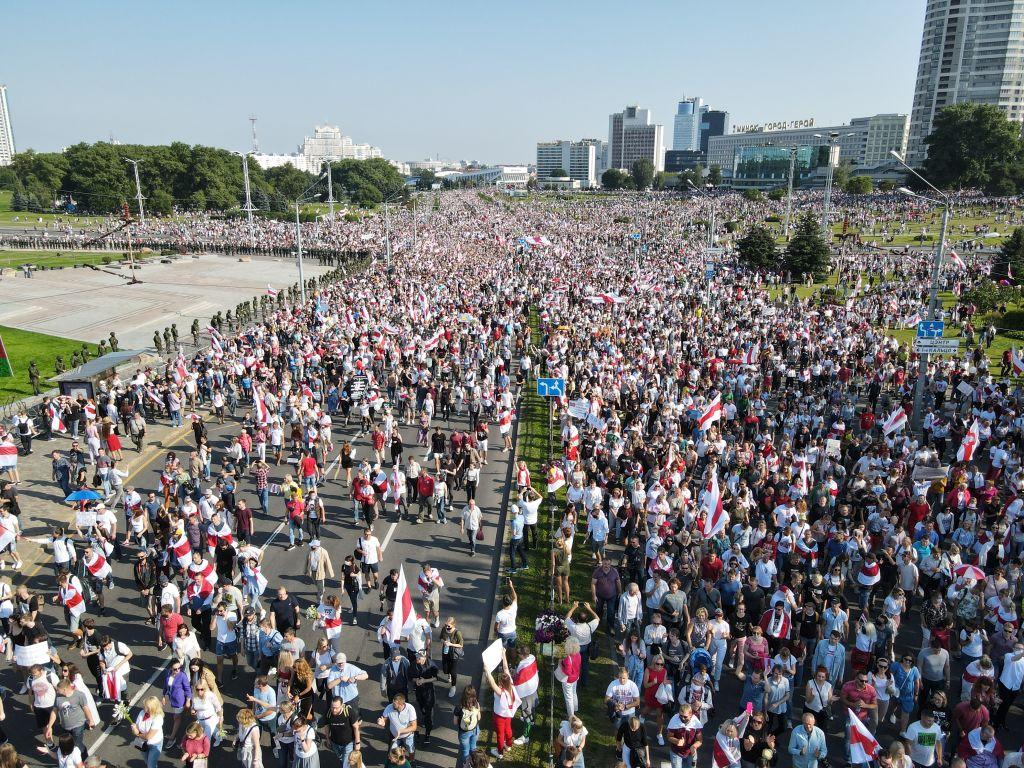
Things are not going Belarusian President Alexander Lukashenko’s way. Since the fraudulent presidential election on 9 August, the security services have been trying to carry out Lukashenko’s order to end the peaceful protests against his regime. In recent days, riot police (OMON) have returned to the streets and resumed arresting protesters, but most detainees are now being fined rather than beaten. The authorities have also hounded journalists, revoking accreditations and deporting those without the proper papers.
To create the impression that the regime has regained control of the country’s public spaces, the authorities last week rushed to disperse each new demonstration in Independence Square. But they were met by masses of Belarusian women. On 29 August, some 10,000 people turned out, leading the OMON to scramble for control, barking orders over loudspeakers and issuing violent threats.
In an attempt to round up the demonstrators, the police barricaded the city’s main squares, stopping traffic. But the women were not intimidated. They marched straight down Independence Avenue to Yakub Kolas Square, where they spread from the sidewalks into the street, surrounding the police vehicles there.
The OMON troops dared not respond, lest they be seen—or caught on camera—beating women. The barricade of police standing arm in arm looked pitiful as the women marched through and around them, chanting, ‘We are the authorities here!’ They were sending a message to both sides: the regime should know that the opposition is undaunted, and the rest of the opposition should know that the demonstrations will succeed if everyone goes out into the streets.
This latest demonstration had an immediate effect, dispelling protesters’ fear of police violence and exposing the authorities’ ineffectiveness. It has shown that the streets once again belong to the opposition. The city grew loud again, with protest anthems like Kino’s ‘I want changes’ blaring far and wide. Cars honked in solidarity with the demonstrators, and white, red and white flags were everywhere.
The next day, 30 August, tens of thousands of people turned out. This time, the authorities mobilised entire convoys of police vans and trucks filled with OMON personnel, barbed wire and water cannon. They barricaded the two primary rallying points: Independence Square (home to the National Assembly) and the area surrounding the Minsk Hero City Obelisk.
When the demonstrators appeared on Independence Avenue, they were blocked almost immediately. The street was lined on both sides with police vans and officials armed with shields and clubs. Local access streets had been closed, and a large crowd of demonstrators was detained for about an hour; some were arrested.
Still, rather than brazenly beating and torturing protesters, the authorities are now trying to present themselves as representatives of ‘law and order’ who are merely ‘cleaning up’ the streets. But, like their previous strategies, this one has merely galvanised the opposition.
The tens of thousands of demonstrators on 30 August quickly moved towards the Obelisk and marched straight on towards Lukashenko’s presidential palace, where they were met by police vehicles and officers with shields. Once again, the number of protesters was simply too large for the authorities to mount an effective response. Unafraid, the demonstrators walked right up to the police officers, who remained behind their shields.
It was at this point that Maria Kolesnikova appeared. The last of the three women opposition leaders who has remained in Belarus (the others have gone into temporary exile for safety), she requested entry to the palace so that she could begin negotiations with Lukashenko on his peaceful handover of power. This was an important development for the opposition. So far, the authorities have succeeded in keeping the main opposition leaders out of the public sphere, either by driving them into hiding or exile, or by dragging them through Kafkaesque court proceedings.
Of course, Lukashenko is not the kind of politician who will sit down with his opponents and negotiate a compromise, let alone a transfer of power. So, when he made his own public appearance, he was again carrying a Kalashnikov. But the image of a paunchy dictator playing soldier hardly inspires fear and awe; on the contrary, Lukashenko’s risible machismo has only made him a target of open ridicule.
In addition to staging these performances, Lukashenko has also had at least five telephone conversations with Russian President Vladimir Putin in recent weeks. Based on the Kremlin’s statements following these calls, the message has been the same every time: yes, Russia is ready to help, but not yet. When interpreting Putin’s behaviour, one must remember that his main audience is the Russian public, not Belarus. With his popularity plumbing new depths, Putin is concerned about his own domestic position, not Lukashenko’s.
That Lukashenko’s grip on power is increasingly tenuous is probably very clear to the Kremlin leader. Despite barking orders and threatening renewed state violence, Lukashenko’s security services have not managed to clear the streets. There are no signs that the demonstrations will end anytime soon.
In fact, if Lukashenko doesn’t come up with something new, the protests may spread even wider, because people have realised that the authorities are impotent. More important, the security services must see this, too. Lukashenko’s pathetic performances with his Kalashnikov have made a mockery of their efforts to control the streets. A confident ruler would have no need for such macho posturing; nor would he have to keep calling Putin, who evidently has little interest—as of now—in doing anything more than answering the phone.